Ijraset Journal For Research in Applied Science and Engineering Technology
- Home / Ijraset
- On This Page
- Abstract
- Introduction
- Conclusion
- References
- Copyright
Title- Digital Ad-fluence: Unravelling the Influence of Online Ads on Consumer Inclinations
Authors: Divija Chopra, Dr. Swati Mittal
DOI Link: https://doi.org/10.22214/ijraset.2024.62237
Certificate: View Certificate
Abstract
This dissertation investigates the influence of online advertising on consumer inclinations and purchasing behaviour in the digital age. As marketing efforts increasingly shift toward digital platforms, understanding the complex dynamics between online advertisements and consumer decision-making processes has become crucial. The study aims to unravel the intricate relationship between these two elements, providing insights into how online ads shape consumer preferences, attitudes, and purchasing decisions. The research employs a mixed-method approach, combining quantitative data from a survey of 100 respondents with a qualitative review of relevant literature spanning the past 10-20 years. The survey data offers valuable insights into consumers\' perceptions, attitudes, and experiences with online advertising, while the literature review provides a comprehensive understanding of the theoretical underpinnings and empirical findings from prior research. Through factor analysis, the study identifies three key dimensions that collectively explain a significant portion of the variance in consumer behaviour toward online advertisements: the influence of price discounts, satisfaction and engagement levels, and the visual appeal of advertisements. These findings shed light on the critical factors that drive consumer responses to digital marketing campaigns. The dissertation contributes to the growing body of knowledge in digital marketing and consumer behaviour, offering practical implications for businesses and marketers seeking to navigate the ever-evolving landscape of online advertising. By uncovering the underlying mechanisms through which online ads influence consumer inclinations, this research provides valuable insights for developing effective digital marketing strategies that resonate with target audiences and contribute to business success in the digital era.
Introduction
I. INTRODUCTION
A. Background of the study
Digital ad-fluence: Unravelling the Influence of Online Ads on Consumer inclinations will explore the intricate correlation between consumer shopping behaviour and online advertising. Nowadays, internet advertisements are found in almost all corners of the digital world, thus shaping customers proclivities and choices. The Internet marketing industry has attained significant milestones at this time. Using internet facilities to dispense them enables online users to access various promotional marketing advertisements. It comprises mainly display adverts, mobile ones, social media-based ads, electronic mails as well as search engine commercials. Research shows that online advertising has a significant impact on consumers who shop online. Ads greatly affect decisions people make while buying things through the web. This is happening when the advertisement industry is going through complete transformation due to advancement in technology in this current fast-growing age period.
Adverting via the internet is an internet marketing and selling technique that enables advertisers to target specified consumers. In comparison with their closest friends or relatives, newspapers and televisions included, shoppers depend more on online buying when making their purchasing decisions. Because of its unique features, which sets it apart from other means like newspapers and television, online advertising has gained popularity among marketers globally.
B. Significance of the study
Examining the impact of internet advertisements on customer preferences is extremely important in the present digital environment. This study delves deeply into the complex ways that internet advertisements affect and influence customer decisions, going beyond a cursory analysis of the effectiveness of digital advertising. Research on the impact of internet advertisements on consumer preferences is at the forefront of modern marketing, providing valuable insights into the relationship between digital advertising and consumer buying behaviour. This study closes a significant knowledge gap by exploring the complex interaction between internet advertisements and customer decisions.
- Consumer-Centric Marketing Strategies: For companies looking to use consumer-centric marketing tactics, it is essential to comprehend how online advertisements influence customer preferences. Marketers will be able to adjust their advertising strategies so that they are in line with the tastes and habits of their target audience thanks to the insights obtained from this study.
- Informed Decision-Making: In a time when customers are constantly exposed to digital content, understanding the impact of online advertisements helps to promote well-informed choices. Companies may use these insights to improve the efficacy and relevancy of their ads, helping customers make better decisions.
- Enhanced Consumer Engagement: This study is important for the field of customer interaction. Businesses can interact with customers more successfully if they understand how internet advertisements affect consumer inclinations. Through the alignment of adverts with the disclosed interests and behaviours, companies may provide material that is not only viewed, but also actively valued and engaged with. Positive brand-consumer interactions are forged through this deeper engagement, which also helps to foster enduring brand loyalty.
- Adapting to Evolving Consumer Trends: Consumer patterns are changing quickly, and this is resulting in a constantly changing digital world. This research offers a compass for firms to manoeuvre through these shifts. Organizations may respond quickly and make sure their advertising tactics are up to date and in accordance with the changing tastes of their target market by having a thorough understanding of how online advertisements impact consumer inclinations.
- Competitive Edge in Digital Marketing: Gaining a competitive advantage in the field of digital marketing is an ongoing endeavour. This study puts companies in a position to gain that kind of edge. Equipped with an enhanced comprehension of the ways in which online advertisements impact consumer decisions, companies may set themselves apart from their rivals by developing advertising strategies that are more efficient, focused, and customer focused. Increased market influence and brand visibility result from this competitive advantage.
- Ethical Considerations and Consumer Empowerment: This study makes a significant contribution to the growing conversation about ethical issues in digital advertising. It creates opportunities for ethical advertising practices by illuminating the possible influence of online advertisements on customer decision-making. The results have wider ramifications for consumer empowerment, promoting a setting in which people are shielded from possibly deceptive practices and given the ability to make knowledgeable decisions.
C. Introduction
Over the last decade, technology has improved significantly changing radically how people advertise products over the web. The advent of new media platforms and communication channels has influenced the global advertising industry landscape drastically. With a high level of potential for growth in its future development, initial signs indicate that online advertising will soon become one of the most popular forms of advertising. Online advertising is a contemporary term referring to ads posted on the World Wide Web. It is currently today’s latest form of commercialism as well as it’s growing faster than any other medium now in use.
The internet is widely used by people as their primary source for several types of information and all kinds tools for communication necessitates this shift towards more adverts being placed on digital channels rather than traditional ones such as newspapers since they are most likely to reach many readers at once.
It helps consumers who shop online have a fresh fast experience.
Online Advertising refers to advertisements that are delivered to users through websites, email etc.
Web advertising is mainly made up of banner ads, rich media ads, email advertising, web classifieds, social media ads, display ads, mobile adverts and contextual on search engine result pages.
Online advertising also referred to as web advertising or internet advertising is a form of marketing that reaches consumers via the internet with promotional marketing messages. This means that online advertising has a great impact on many people who are using the internet since it can reach many audiences over the internet. The main purpose of online advertisers is to get in touch with customers and influence their purchasing behaviour, knowledge, and decision-making process. The intention for those who advertise online is to create visually interesting online advertisements that will increase demand among various users on the web for their products or services.
Online advertisements:
When we say online advertisements what we mean is companies selling their goods on the internet. YouTube videos and banners from other websites as well as social networking sites such as Pinterest, Instagram Facebook Google among others are some of the platforms used by advertisers who want to reach out to more customers. There exist different forms of online ads including:
- Banner Ads
- Promotion through Social Media
- Video Commercials
- Pop-Up Ads
- Newsletter Advertising
- Search Engine Optimization
- Banner Ads: These are graphic advertisements, which may be in the form of banners, pictures or interactive multimedia on websites or applications. They aim to appeal to users by displaying merchandise, services, or brand messages for user engagement. Display ads are customized based on a user’s activity, interests, or demographics.
- Promotion through social media: Advertising through Facebook, Instagram and Pinterest is cheap. These adverts are paid for adverts. Businesses can tell who they are on social media platforms too. Like Facebook, the organization will be able to create its page itself. Users would love this page and leave product-related comments below them while others go ahead and tag their friends or families making a network around it.
- Video commercials: You can help advertise an organization's products by uploading short films onto the internet. These videos are intended for certain groups of people who use search queries for buying purposes. This video advertisement could be put on YouTube among some videos like movies, TV shows, etc. In addition to sharing their advertising either on their webpages or after other videos advertisers pay a share of what they earn to the owner of each page where it was displayed.
- Pop ads: When users click on a link or visit a Web site, pop ads are usually displayed in a separate window of the browser. They are useful, but some people believe they could be intrusive.
- Newsletter advertising: as part of this kind of advertising, you send personal emails to a list of recipients. Sending a newsletter, promotions, discounts, and personalised content is part of this strategy in order to attract leads and retain customers.
- Search engine optimization: Increasing a website's presence on search engines through optimization is known as SEO. It involves improving meta tags, content, and other components to increase the rank of search engine results and drive more organic traffic.
II. LITERATURE REVIEW
A. erature Review from last 10 to 20 years articles
- Njuguna Ngure Alvin (2017) According to Njuguna Ngure Alvin (2017), internet advertising is crucial for fostering consumer engagement and raising brand exposure. However, there are several obstacles that influence how internet advertisements influence consumer decisions. For example, a customer's attitude may have an impact on their mental state regarding a certain issue. Customers belonging to various sectors, such as age, location, and lifestyle, also have a big influence on what they buy. The primary point is that internet advertising is starting to function as a tool for customer choice.
- Manju Ahuja (2003) In their paper, which focused mostly on examining the factors influencing consumers' browsing and purchasing behaviour’s during online transactions, a study was conducted on users of business-to-client websites. The researchers additionally checked out the purchasing choices of customers with a range of demographic profiles, which may have shown unique client behaviours and shopping processes for a certain quality of goods and services.
- Mohammed and Alkubise (2012) mentioned that a few important variables that influence online advertising are income, daily internet usage and abilities, the substance of advertisements, and the location of advertisements. They also concluded that consumer reviews have a big influence on what people buy online. Customer reviews of websites and items are read before making any online purchases. The primary determinant of an online buyer's behaviour is their attitude, which can be influenced by several factors, including brand loyalty, value, prior online purchase experience, and comments or opinions from other customers.
- Bakshi G. (2013) in his study mediums such as Pinterest, social media marketing, and mobile marketing. He also said, "The World Wide Web is increasingly turning into a standard platform for advertisements as a result of the increased use and growth of the Internet. The Web is providing a worldwide reach, sophisticated media tools, and interactive services for corporate advertisements. To make the most of this new media, it is necessary to comprehend the target audience and then cautiously plan your strategies.
- Muhammad Ehsan Malik (2013) concluded in their 2013 research article, hat brand advertisements significantly affect consumers' purchasing decisions and have a significant impact on the brand's image.
Additionally, it was concluded that there is a strong correlation between advertisements and customer purchasing behaviour. Customers will rather purchase products that are heavily promoted than ones that are barely or never advertised.
6. Kalia and Mishra (2016) acknowledge that online advertisements are quite successful. Nevertheless, other noteworthy findings have been made, such as the effectiveness of online moveable advertisements with Visuals, music, and animations. Internet advertisements solely serve to inform customers about the goods. Due to trust concerns, many customers would rather make purchases via a company's official website than by clicking on internet advertisements.
7. Anusha (2019) discovered in her research that online advertising favourably influences customer purchasing decisions by raising product awareness. Additionally, it offers a cutting-edge way to instantly target the customer. It lowers the price as well. Another result is that, despite customers using the internet to research items and visit websites that advertise them, there is a problem with trust due to fraud and unethical promotions.
8. According to Bhat, Shetty, and Maiya's (2020) research, internet advertisements are now the most popular way to reach customers when compared to traditional forms of advertising. A notable feature of various alternative advertising techniques is the broad degree of confirmation provided by the internet. Online ads help businesses anticipate how their clients will make purchases. Due to digitization, the great majority prefers to shop online because it's easier, faster & convenient than using a traditional method.
9. Gursakal (2009) This study examines how much time consumers spend on social media and the internet, as well as the impact of media society. The patterns of consumption have changed recently. Customers and dealers are using e-mails, websites, and social media to share statistics, which has changed how they use magazines, interviews, and catalogues. Because social media is so effective, people are spending more time online and are turning away from traditional search methods. Social media has emerged as a key platform for announcing opportunities, marketing items, and providing product commentary. Gursakal (2009
10. Tashrifa Haider and S. Shakib's study of the literature looks at how online advertising affects consumers' purchasing decisions. Studying four independent variables (familiarity, expenditure, social imaging, and entertainment value of advertising), the research finds that advertisements have a big influence on consumer buying decisions. It highlights how advertising has changed throughout decades The study emphasizes how crucial it is for marketers to comprehend how advertising influences customer preferences and what elements of it work best.
11. Muhammad Aqsa& Dwi Kartini (2015) discovered that there is a significant growth in internet users due to technology's ongoing development. Since devices like PCs, laptops, mobile phones, tablets, and other gadgets are used to access the internet, it is imperative to leverage the significant consumer base for online advertising. The study also discovered that, despite its effectiveness, online advertising can only be directed towards individuals who regularly use the internet.
12. Shaina Tehri’s study delves into evaluating how well advertising influences the purchasing decisions of consumers. The study concludes that most customers are, in fact, impacted by advertising when making purchases. It's been seen that celebrity endorsements increase influence. The study identifies television commercials as having a particularly strong impact and attributes this to the performers' influence and the concepts they present. The study proposes that firms should consider advertisements as a form of investment rather than just an expense, highlighting the significant influence that ads have on customer behaviour.
13. In their research, Danaher and Mullarkey (2003) noted that internet and web advertisements have a significant effect on customers. It facilitates their ability to identify the product and retrieve their memories of it. It was also claimed that individuals prefer moving pictures to plain, inflexible ads.
14.The 2013 study by Teena Bagga looks at both external and internal factors that affect customers' online purchasing decisions. The study finds seven major elements influencing consumer behaviour through the use of an organized questionnaire with one hundred samples: the need for social connection, the characteristics of websites, online marketing, task simplicity, concerns over privacy, and information search. The study used online and mail-based questionnaires, highlighting the importance of both methods in comprehending and forecasting online buying behaviour.
15. Subhankar Das uses Maslow's hierarchy of needs to classify demands in his study, which investigates the impact of media on consumer purchasing behaviour. The study highlights the importance of media in improving brand image.
B. Summary of Related Studies
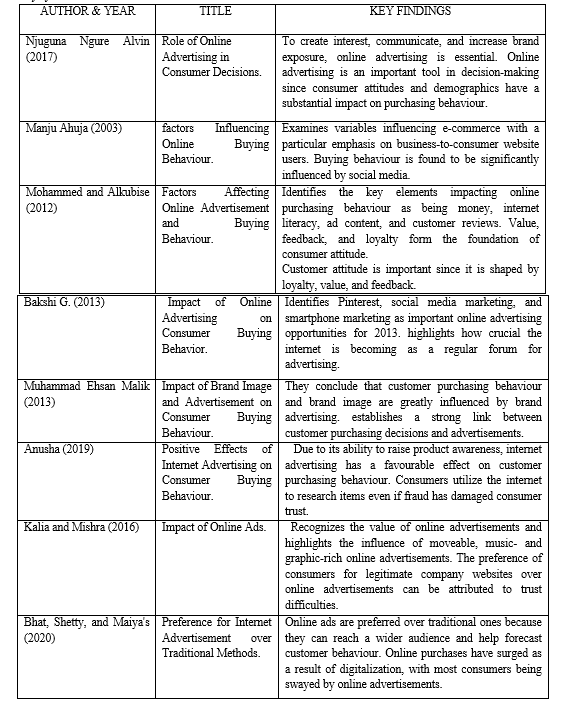
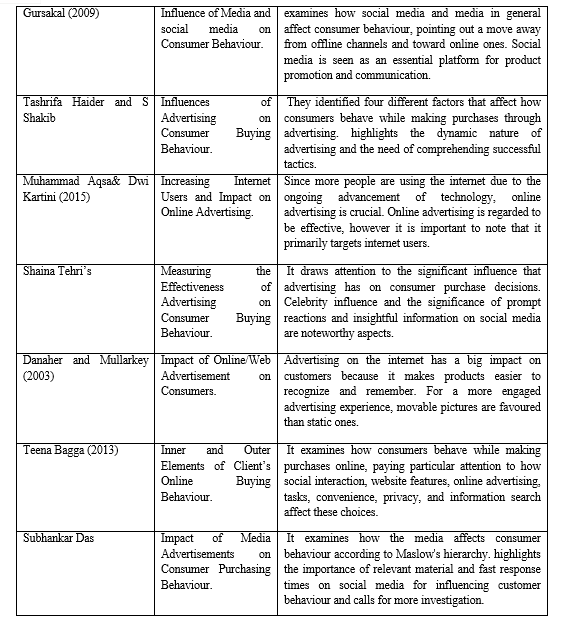
III. RESEARCH METHODOLOGY
This chapter focuses on research methodology that was used in the study. It offers a thorough explanation of the study's chosen research methodology. The target population, study tools, data collection and analysis methodology, and research design are all described in this chapter.
A. Research Design
In this study, descriptive research was conducted. Gathering information about events and organizing, tabulating, illustrating, and characterizing the data gathering are all part of descriptive research. It often provides a clearer picture of the effectiveness and dependability of online advertising as well as how it relates to purchase decisions by using visual aids like pie charts and graphs to help the reader understand the data distribution.
B. Data Type
Primary and Secondary
Primary data were collected through a questionnaire, while secondary data included research papers and literature reviews.
C. Primary Data Collection Method-
To collect the data a questionnaire was used which was sent out by WhatsApp and social networking apps i.e. in a digital form.
D. Sampling Method
Convenience sampling was chosen. It is a sampling method adopted when researchers collect the data from a conveniently available pool of respondents. It was used because it's incredibly prompt, simple, and economical.
Sample Size- 100 Respondents
Location-. The samples were taken from within Delhi NCR.
E. Data analysis tool
Data Analysis Tool: Pie Charts and factor analysis
Pie charts were utilized to present the analysed data and SPSS Software was used.
IV. DATA ANALYSIS AND INTERPRETATION
The analysis and study results are presented in this chapter according to the research technique. The impact of online advertising on consumer purchasing behaviour was the subject of a presentation. The goal of the study was:
- To Know the concept of Online Advertising.
- To study the impact of online Ads on Consumer Behaviour.
- To find out the factor influencing consumer’s buying decisions.
A. Primary Data Representation -
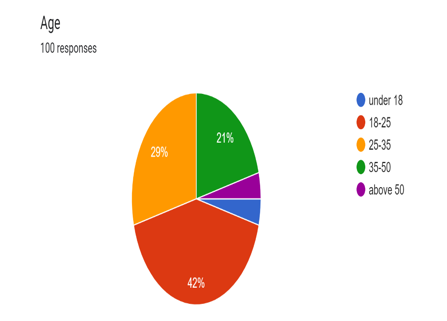
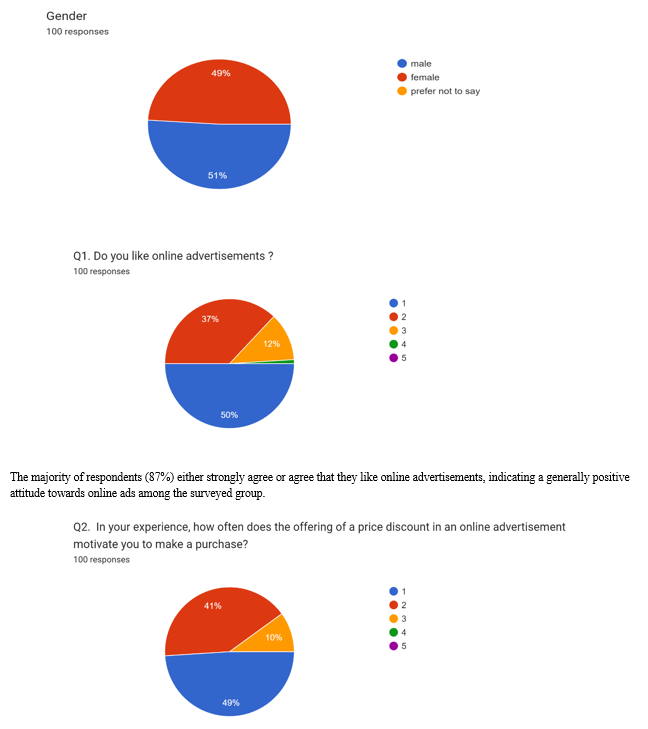
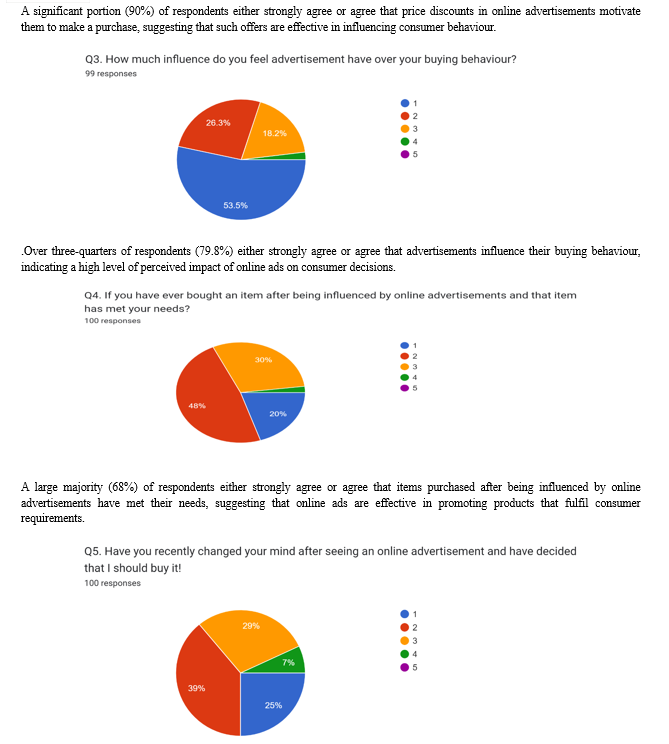
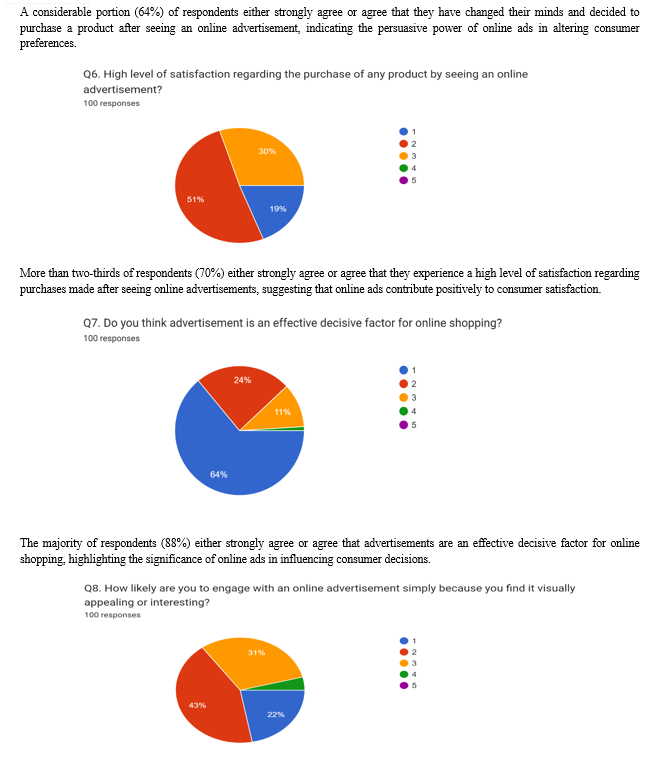
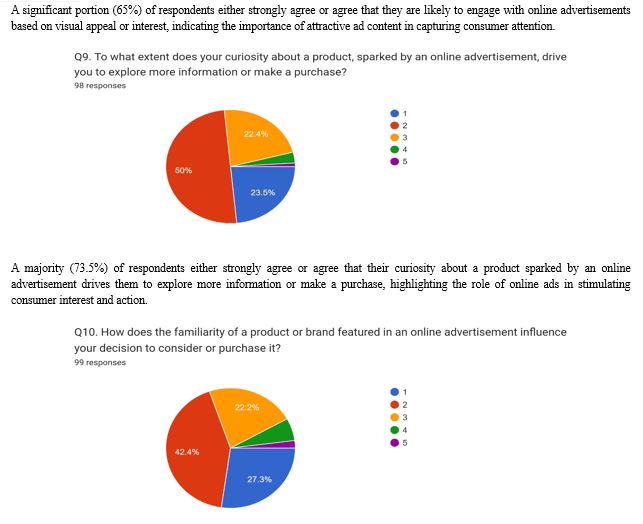
A substantial portion (69.7%) of respondents either strongly agree or agree that the familiarity of a product or brand featured in an online advertisement influences their decision to consider or purchase it, underscoring the impact of brand recognition and familiarity in consumer choices.
The survey successfully achieved its three primary objectives:
- Core Concept of Online Advertising: The survey revealed that 87% of respondents either strongly agreed or agreed that they like online advertisements, indicating a generally positive attitude toward online ads. Participants responses to questions about the influence of online ads on their buying behaviour and their satisfaction with ad-influenced purchases provided insights into their understanding and perception of online advertising.
- Impact of Online Advertisement on Consumer Behaviour: The survey data demonstrated the impact of online advertisements on consumer behaviour through various findings: A significant proportion of respondents acknowledged the influence of online platforms on their perceptions (79.8%) and indicated that online advertisements affect their buying behaviour (88%). Responses indicated that online ads influence purchasing decisions, with 44% of participants admitting to making buying decisions influenced by online ads. Moreover, a considerable portion of respondents (64%) agreed that advertisements are an effective decisive factor for online shopping.
- Factors Influencing Consumer's Buying Decision: The survey data highlighted several factors influencing consumers' buying decisions, including price discounts, visual appeal of ads, curiosity sparked by ads, familiarity with products or brands, and overall satisfaction with ad-influenced purchases.
Responses to questions such as the influence of price discounts, engagement with visually appealing ads, and the role of curiosity and familiarity provided insights into these factors. By examining these responses, the survey successfully identified key factors influencing consumer buying decisions in the context of online advertising.
B. Factor Analysis – using SPSS software.
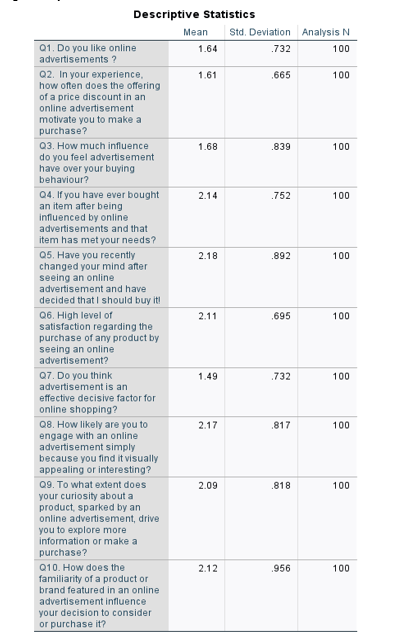
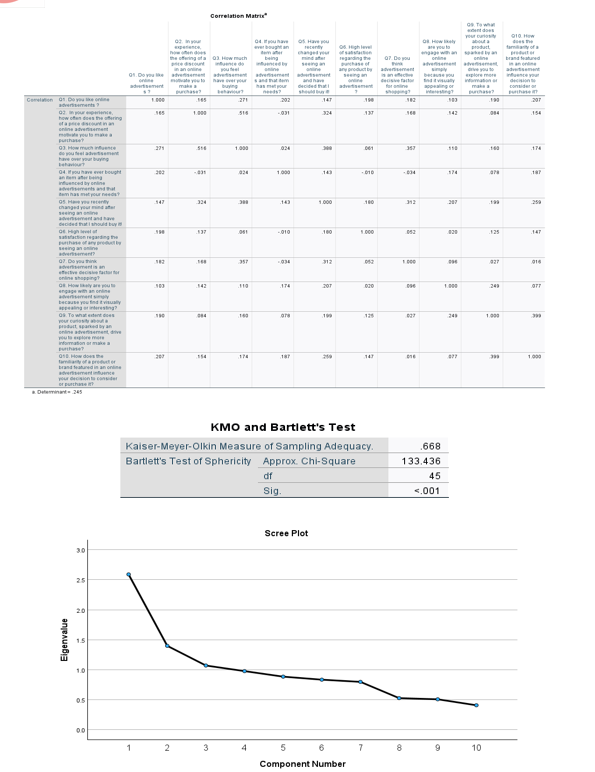
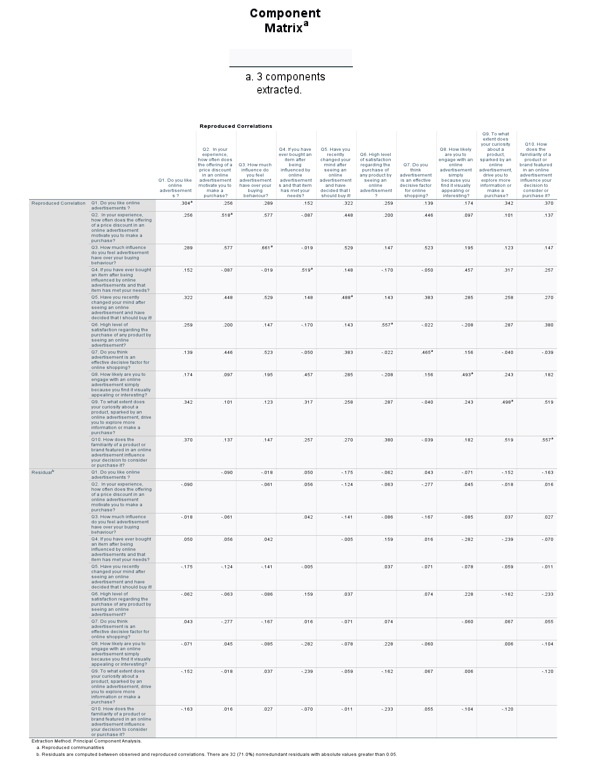
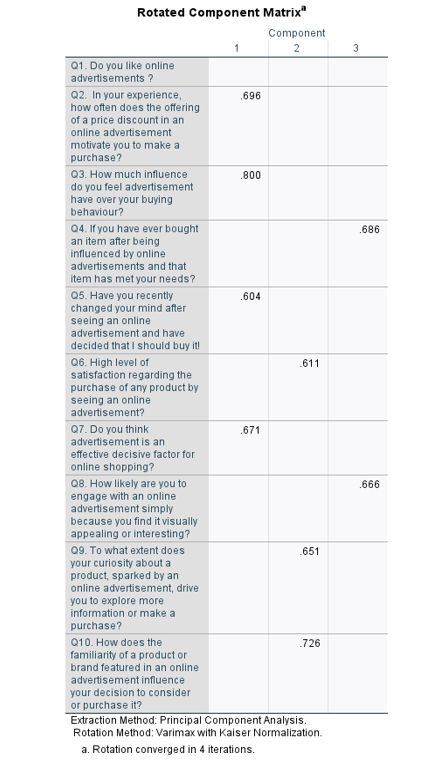
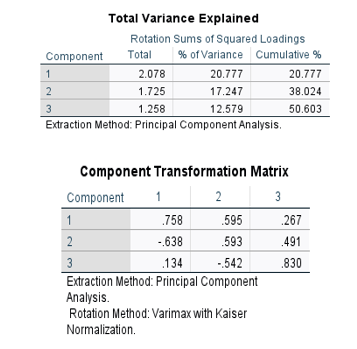
Analysis
The factor analysis aimed to identify the underlying dimensions or factors that influence consumers' behaviour regarding online advertisements. The analysis extracted key factors, as indicated by the Total Variance Explained table.
Factor 1 (explaining 20.777% of the variance): Based on the questions Q2, Q3, Q5, and Q7, this factor likely represents the "Influence of Price Discounts in Online Advertisements." Variables related to the motivational impact of price discounts, the perceived influence of advertisements on buying behaviour, and the effectiveness of advertisements in driving online shopping decisions may have loaded highly on this factor.
Factor 2 (explaining 17.247% of the variance): Based on questions Q6, Q9, and Q10, this factor could represent "Satisfaction and Engagement with Online Advertisements." Variables such as the level of satisfaction with purchases influenced by online advertisements, the impact of curiosity sparked by advertisements on further exploration or purchases, and the influence of brand/product familiarity featured in advertisements may have loaded onto this factor.
Factor 3 (explaining 12.579% of the variance): Based on questions Q4 and Q8, this factor likely relates to the "Visual Appeal and Engagement with Online Advertisements." Variables concerning the influence of visually appealing or interesting advertisements on engagement and potential purchases, as well as the past experiences of buying items influenced by online advertisements that met consumer needs, may have loaded onto this factor.
The high values in the Component Transformation Matrix suggest strong correlations between the extracted factors and the original variables, reinforcing the interpretation of these factors as meaningful constructs related to the influence of online advertisements on consumer behaviour.
The factor analysis revealed three key factors that collectively explain 50.603% of the total variance in consumer behaviour regarding online advertisements. Factor 1, explaining 20.777% of the variance, highlights the significant influence of price discounts offered in online advertisements on consumer behaviour. Factor 2, accounting for 17.247% of the variance, underscores the importance of satisfaction and engagement with online advertisements, driven by factors such as curiosity, familiarity, and past experiences. Factor 3, explaining 12.579% of the variance, emphasizes the role of visual appeal in driving consumer engagement and potential purchases from online advertisements.
Conclusion
A. Key Findings 1) Key findings of Primary Data: a) Positive Attitude Towards Online Advertisements: The majority of respondents (87%) indicated a liking for online advertisements, suggesting a generally favourable perception of online ads among the surveyed group. b) Effectiveness of Price Discounts: A significant portion (90%) of respondents expressed that price discounts offered in online advertisements motivate them to make purchases, highlighting the effectiveness of promotional offers in influencing consumer behaviour. c) Perceived Influence of Advertisements: Over three-quarters of respondents (79.8%) believe that advertisements have a significant influence on their buying behaviour, indicating a high level of perceived impact of online ads on consumer decisions. d) Satisfaction with Ad-Influenced Purchases: A majority (70%) of respondents reported a high level of satisfaction with purchases made after seeing online advertisements, suggesting that online ads contribute positively to consumer satisfaction. e) Impact on Decision-Making: The majority of respondents (88%) consider advertisements to be an effective decisive factor for online shopping, underscoring the significant role of online ads in influencing consumer decisions. f) Role of Curiosity and Familiarity: A large portion of respondents expressed that curiosity sparked by online advertisements (73.5%) and familiarity with featured products or brands (69.7%) drive them to explore more information or consider making a purchase, highlighting the importance of these factors in consumer behaviour. 2) Key Findings of Factor Analysis: These underlying factors were identified that collectively explain the variance in consumer behaviour towards online advertisements. a) Price Discounts as a Major Influencer: The factor analysis revealed that the \"Influence of Price Discounts in Online Advertisements\" emerged as the most significant factor, explaining 20.777% of the total variance. This finding highlights the substantial influence that price discounts featured in online advertisements have on consumer behaviour. Consumers are highly motivated by discounted prices, and these discounts can effectively sway their purchasing decisions and perceptions of the effectiveness of online advertisements. b) Satisfaction and Engagement as Critical Drivers: The second factor, \"Satisfaction and Engagement with Online Advertisements,\" accounted for 17.247% of the total variance. This factor underscores the importance of consumers\' satisfaction with previous purchases influenced by online advertisements, as well as their overall engagement with such advertisements. Factors such as curiosity sparked by advertisements, familiarity with the product or brand, and past satisfaction levels play a significant role in determining consumers\' willingness to explore and potentially make purchases based on online advertisements. c) Visual Appeal as a Key Engagement Factor: The third factor, \"Visual Appeal and Engagement with Online Advertisements,\" explained 12.579% of the total variance. This finding emphasizes the influence of visually appealing or interesting online advertisements on consumer engagement and potential purchases. Consumers are more likely to engage with and potentially be influenced by advertisements that they find visually appealing or interesting, even if they were not initially interested in the product or brand. d) Collective Influence of Factors: Together, these three factors account for 50.603% of the total variance in consumer behaviour regarding online advertisements. This suggests that the combination of price discounts, satisfaction, and engagement levels, and visual appeal captures a significant portion of the underlying dimensions that influence consumer responses to online advertising campaigns. The high values in the Component Transformation Matrix indicate strong correlations between the extracted factors and the original variables. This reinforces the interpretation of these factors as meaningful constructs that are interconnected and collectively shape the influence of online advertisements on consumer behaviour. B. Conclusion In the digital age, this dissertation has conducted a thorough investigation on the impact of internet advertisements on consumer inclinations in an environment where consumer behaviour is closely linked to the abundance of online content. An intricate picture of the changing environment and the dynamic interaction between internet ads and consumers has been woven together from the synthesis of survey responses and secondary research findings. A noteworthy of respondents indicated a positive attitude, which is indicative of a positive opinion of internet ads. The fact that respondents preferred online media over conventional media further demonstrates the strength of digital channels and places them in a prime position to shape consumer preferences. The study revealed the impact of online advertisements on their purchasing decisions, and participants were unsure about how often they watched online advertisements. These results highlight the necessity for ongoing modification and refinement to be in line with a range of customer feelings and point to complexity within the efficacy of digital advertising schemes. A wave of change in the advertising industry is indicated by the overall trend of respondents perceiving online advertising as highly successful. Digital media platforms are no longer only a means of promoting brands; they are becoming powerful agents influencing customer behaviour. The way that this impact has changed perceptions about marketing reach and impact is a result of the dynamic synergy that exists between consumers and online advertisements. In conclusion, this study sheds light on the complex dynamics that exist between consumers and internet marketing. For companies and marketers attempting to navigate the complex world of digital advertising, the findings provide a useful compass.
References
[1] https://www.researchgate.net/publication/359758883_Effect_of_Online_Advertisement_on_Consumer_Buying_Behaviour-A_Review [2] https://core.ac.uk/download/568379918.pdf [3] www.google.com [4] https://www.researchgate.net/publication/357770151_IMPACT_OF_ONLINE_ADVERTISEMENT_ON_CONSUMER_BUYING_BEHAVIOR_A_STUDY_IN_TRIPURA_INDIA [5] https://www.emarketer.com/ [6] https://www.lbef.org/journal/2-1/download/2-1-59-72.pdf [7] https://www.bsssbhopal.edu.in/uploads/naac/criteria_1/students_projects/056%20Ashish%20K%20Dandpat.pdf [8] https://www.scribd.com/document/577091919/ONLINE-ADVERTISMENT-CONSUMER-BUYING-BEHAVIOUR [9] www.scribble.com [10] https://www.researchgate.net/publication/344771578_IMPACT_OF_ONLINE_ADVERTISING_ON_CONSUMERS_BUYING_BEHAVIOUR_A_STUDY_WITH_REFERENCE_TO_KARKALA_TALUK [11] https://papers.ssrn.com/sol3/papers.cfm?abstract_id=4153473 [12] https://www.researchgate.net/publication/318429556_IMPACT_OF_ONLINE-ADVERTISING_ON_CONSUMERS [13] https://www.ijcrt.org/ [14] https://www.academia.edu/42820157/EFFECT_OF_ONLINE_ADVERTISING_ON_CONSUMER_BUYING_BEHAVIOUR_OF_INTERNET_USERS_IN_LAGOS_STATE [15] https://www.abacademies.org/articles/A-study-on-the-influences-of-advertisement-on-consumer-buying-behavior-1944-6578-9-1-105.pdf [16] https://ijcrt.org/papers/IJCRT2208244.pdf [17] http://lrc.acharyainstitutes.in:8080/jspui/bitstream/123456789/3428/1/A%20Study%20on%20Effect%20of%20Online%20Advertising%20on%20Consumer%20Buying%20Behaviour%20at%20OAA%20Pvt.%20Ltd.%2C%20Bengaluru.pdf [18] https://www.ijrar.org/download1.php?file=IJRAR19J2995.pdf [19] https://www.jetir.org/papers/JETIR2403175.pdf [20] https://www.researchgate.net/publication/359758883_Effect_of_Online_Advertisement_on_Consumer_Buying_Behaviour-A_Review [21] https://www.bsssbhopal.edu.in/uploads/naac/criteria_1/students_projects/056%20Ashish%20K%20Dandpat.pdf [22] http://lrc.acharyainstitutes.in:8080/jspui/bitstream/123456789/3428/1/A%20Study%20on%20Effect%20of%20Online%20Advertising%20on%20Consumer%20Buying%20Behaviour%20at%20OAA%20Pvt.%20Ltd.%2C%20Bengaluru.pdf [23] https://papers.ssrn.com/sol3/papers.cfm?abstract_id=4153473 [24] https://www2.bartleby.com/essay/Literature-Review-On-Consumer-Behavior-Towards-Advertisement-PCR2V73LE6 [25] https://wjarr.com/sites/default/files/WJARR-2022-0577.pdf [26] https://eprajournals.com/IJSR/article/11351/download [27] http://www.ijream.org/SpecialIssueConference/ICDOMP2019018.pdf [28] https://nairaproject.com/projects/2118.html [29] https://www.ijmcer.com/wpcontent/uploads/2022/04/IJMCER_U0420207216.pdf [30] https://www.scribd.com/document/577091919/ONLINE-ADVERTISMENT-CONSUMER-BUYING-BEHAVIOUR
Copyright
Copyright © 2024 Divija Chopra. This is an open access article distributed under the Creative Commons Attribution License, which permits unrestricted use, distribution, and reproduction in any medium, provided the original work is properly cited.

Download Paper
Paper Id : IJRASET62237
Publish Date : 2024-05-16
ISSN : 2321-9653
Publisher Name : IJRASET
DOI Link : Click Here
 Submit Paper Online
Submit Paper Online

